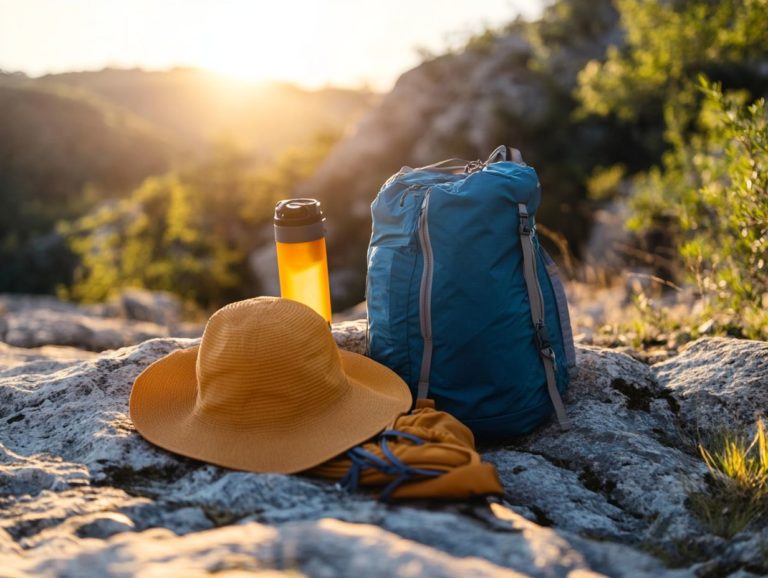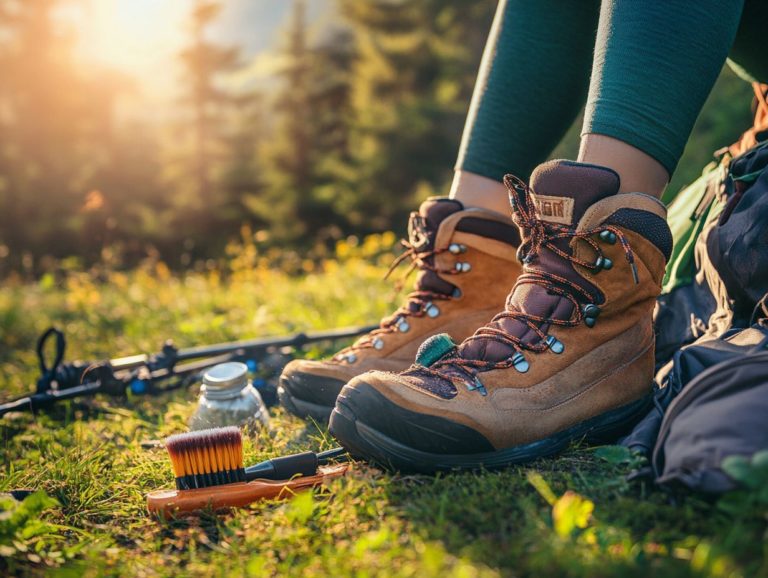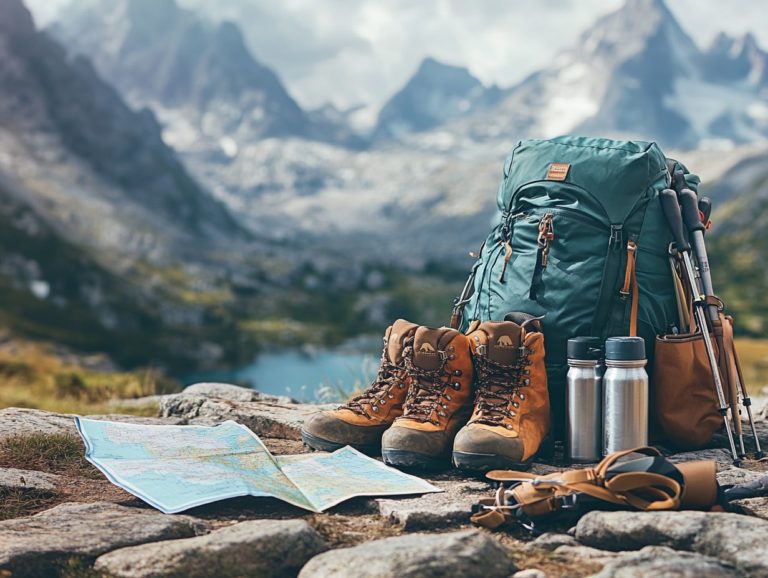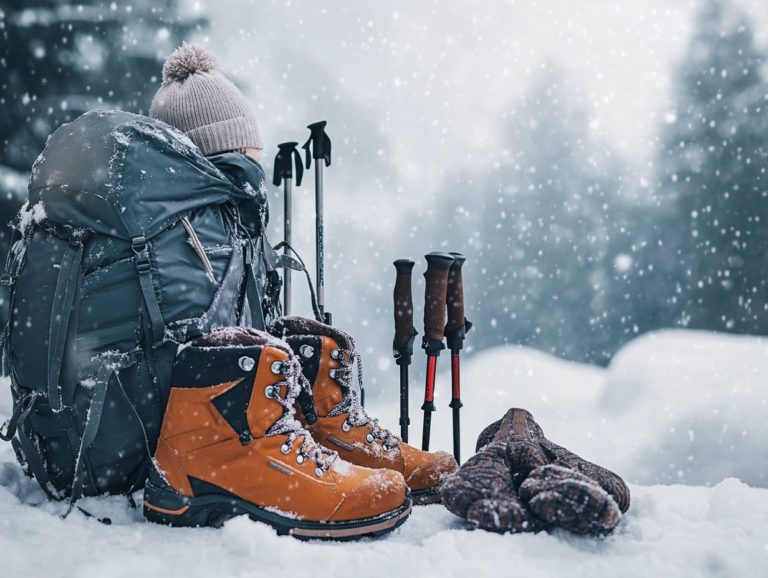Choosing the Right Tent for Backpacking
Choosing the right backpacking tent can truly shape your outdoor experience. With a plethora of options available, it s crucial to evaluate factors such as tent size, weight, and waterproofness to ensure your camping gear aligns perfectly with your needs.
From freestanding models to ultralight designs, each structure type presents its own set of advantages. This guide will help you discover vital features that can elevate your outdoor adventures!
Contents
- Key Takeaways:
- Factors to Consider When Choosing a Backpacking Tent
- Types of Backpacking Tents
- Features to Look for in a Backpacking Tent
- Tent Set-Up and Maintenance Tips
- Frequently Asked Questions
- What should I consider when choosing the right tent for backpacking?
- How do I determine the appropriate size of tent for backpacking?
- What is the difference between a 3-season and 4-season tent?
- What materials should I consider for a backpacking tent?
- How important is the weight of a backpacking tent?
- Do I need to spend a lot of money on a backpacking tent?
Key Takeaways:
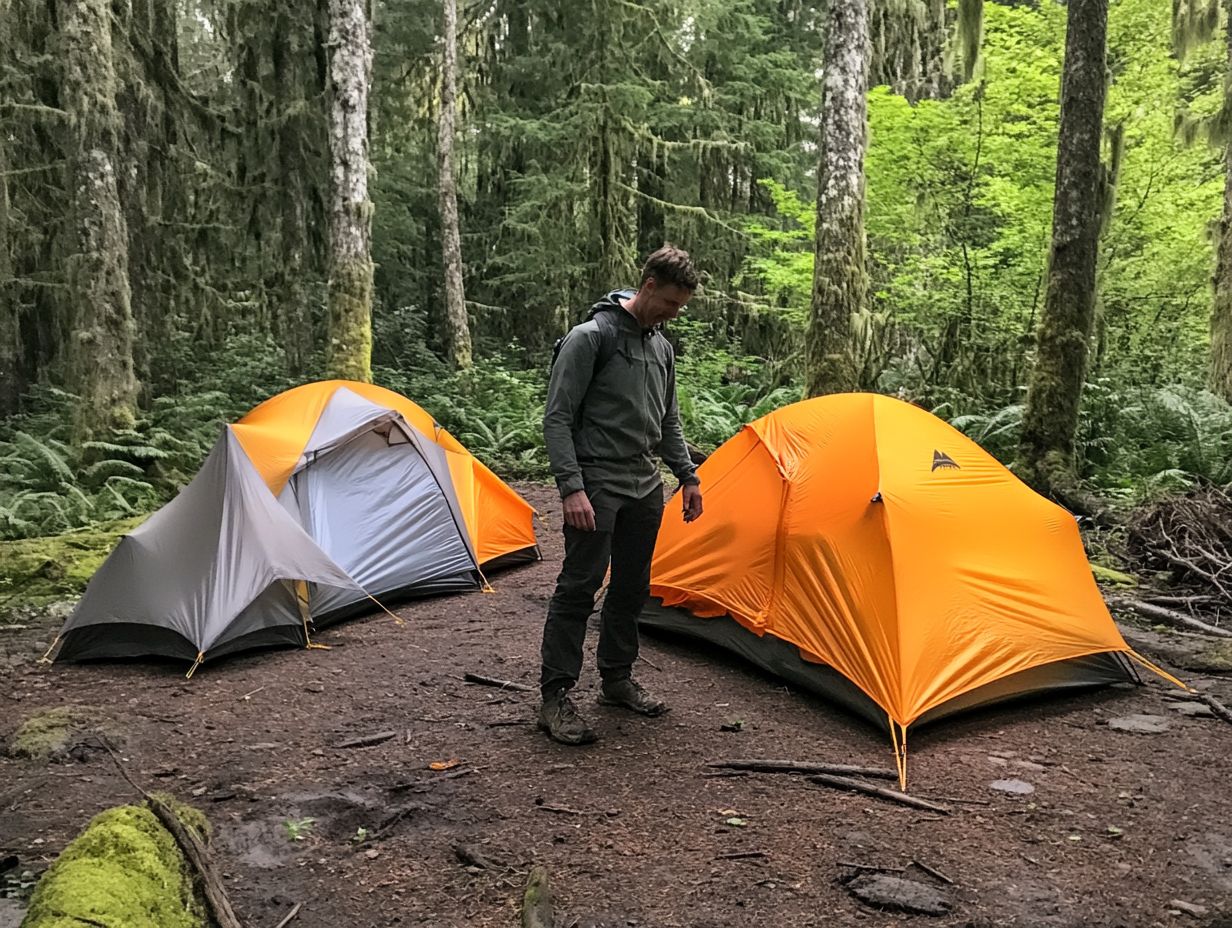
- Consider size, weight, and waterproof features when choosing the best backpacking tent.
- Select freestanding, semi-freestanding, trekking pole, or ultralight tents based on your preferences and needs.
- Look for tents with good ventilation, durable materials, and learn proper setup, inspection, and maintenance techniques for a longer-lasting tent.
Factors to Consider When Choosing a Backpacking Tent
The ideal backpacking tent demands a thorough evaluation of key factors to guarantee your comfort, durability, and performance outdoors. You’ll want to consider tent size and capacity, as well as weight and portability, since each element is pivotal in selecting the right gear for your backpacking adventure.
Account for seasonality, warmth, and livable space to meet your specific needs, while ensuring the tent’s design and materials offer robust protection against the elements.
Consider the tent’s waterproof features, fabric thickness, and packed size, as they can greatly influence your camping experience, making it essential to assess these attributes carefully.
Tent Size and Capacity
Tent size and capacity are crucial when selecting a backpacking tent, as they determine the livable space available for you and your gear. The right tent size enhances comfort. A cramped tent makes movement difficult, while a large one adds unnecessary weight.
When planning for a group, consider not just the number of people, but also the amount of equipment that will be inside. Thoughtfully evaluating these factors ensures a more enjoyable and restful experience, deepening your appreciation for the great outdoors.
Weight and Portability
When backpacking, the weight and portability of your tent are critical, as they directly influence how easily you can carry all your essential camping gear. Lightweight tents let you travel further with less effort! Their compact design means more space for gear.
This reduced bulk not only boosts your mobility but also simplifies the setup process when you reach your campsite. You ll spend more time soaking in the great outdoors instead of struggling with unwieldy equipment.
The convenience of quick and efficient tent assembly can transform a long day of trekking into a delightful nighttime retreat, perfectly catering to your desire for an unobstructed wilderness experience.
Seasonality and Weather Resistance
Know your tent’s seasonality. Choosing the right tent for the season keeps you safe and comfortable. Four-season tents are engineered to endure harsher climates, boasting strong waterproof materials that keep moisture at bay during unexpected rain or snow.
Pay attention to fabric thickness; fabrics with higher thickness offer increased durability and tear resistance, which is essential for tackling rugged outdoor environments. By choosing the right tent with the right specifications, you’re safeguarding yourself from the elements while enhancing your overall camping experience, allowing for delightful explorations in nature’s ever-changing seasons.
Types of Backpacking Tents
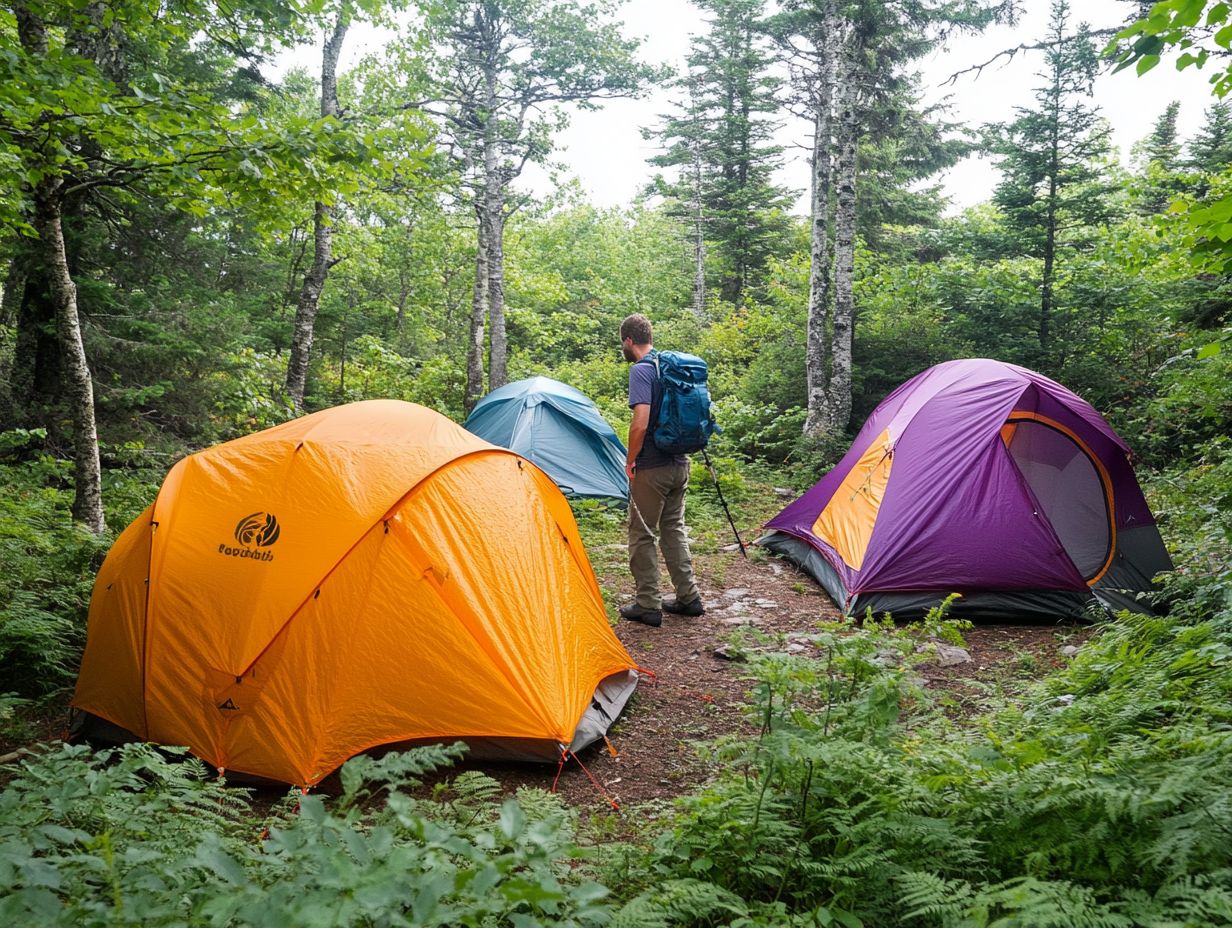
Understanding the different types of backpacking tents is crucial for making an informed choice that aligns with your outdoor adventures. Each tent structure be it freestanding, semi-freestanding, single-wall, or double-wall has its own advantages and drawbacks that can influence your camping experience.
Whether you’re hiking a long-distance trail or enjoying a weekend at Rocky Mountain National Park, choosing the right tent can significantly enhance your time outdoors.
Freestanding Tents
Freestanding tents are known for their stability and easy setup, making them a popular choice among backpackers. You can pitch them quickly on various terrains, whether on rocky ground or sandy beaches.
A big advantage of these tents is their lightweight design, so transporting them during long hikes is easy. They typically offer good ventilation and ample space, keeping you comfortable in different weather conditions.
However, keep in mind that while freestanding tents are convenient, they may not be as durable as some specialized tents, especially in extreme weather. It s essential to consider these factors against your camping needs before deciding.
Trekking Pole Tents
Trekking pole tents use your existing trekking poles for support, making them a lightweight and efficient option if you’re looking to minimize gear weight.
This design boosts portability and allows for a quick setup. You ll be ready to enjoy the outdoors in no time.
These tents adapt easily to various terrains, whether rocky, sandy, or uneven, providing stability and protection. Their simple construction makes them accessible for novice campers too.
With just a few components needed for assembly, you can tackle challenging landscapes without the burden of heavy equipment.
Ultralight Tents
Ultralight tents prioritize minimal weight while providing essential features for your backpacking trips. They pack away easily in your backpack, so you won t feel weighed down during long hikes.
These shelters are built for durability, using advanced materials that withstand tough outdoor conditions. Setting them up is simple, making them an invaluable asset, even for beginners.
Features to Look for in a Backpacking Tent
Identifying the right features in a backpacking tent is vital for your comfort and performance on outdoor adventures. Look for aspects like ventilation, material durability, and waterproofing. These factors greatly impact how livable your camping experience is.
Pay attention to how easy it is to set up your tent and the quality of components like stakes and poles. This will enhance your overall satisfaction with your gear.
Ventilation and Breathability
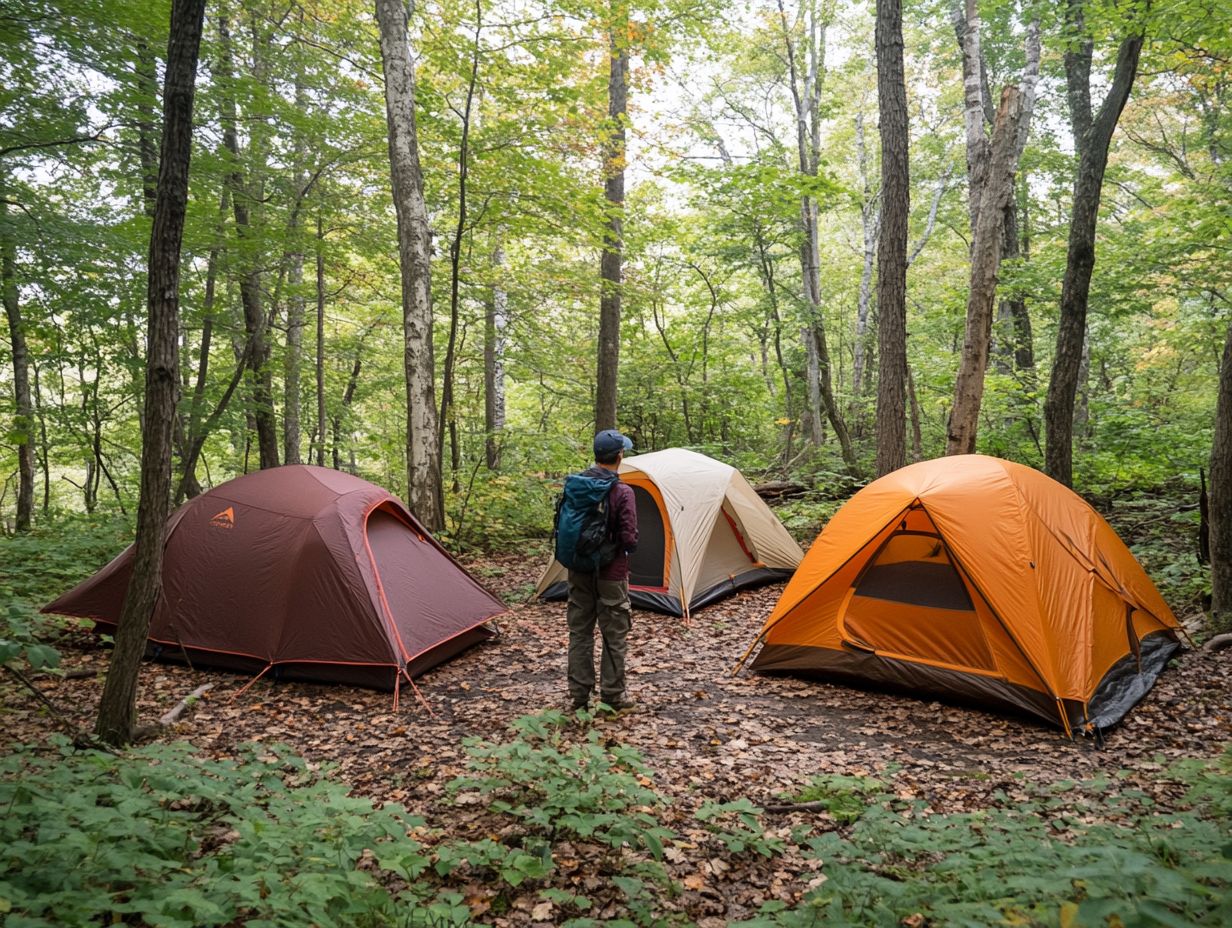
Good ventilation and breathability in your backpacking tent are essential for comfort, especially in unpredictable weather conditions.
When you set off on outdoor adventures, proper airflow not only enhances your sleeping experience but also prevents moisture buildup inside your tent. This is especially important during humid nights or when condensation forms from temperature changes.
A well-designed tent with adequate ventilation, such as mesh panels that allow air to flow while keeping bugs out and adjustable vents, helps reduce stuffiness. This exchange of air leads to a drier environment, minimizing the risk of mold and mildew that can threaten your gear and health.
Effective ventilation is often overlooked but is crucial for superior tent design, enhancing your overall camping experience.
Durability and Materials
The durability of your backpacking tent depends on the materials used, particularly the special layers that keep water out.
These choices significantly affect how well your tent withstands rain and snow and its overall lifespan. Many manufacturers use high-quality polyester or nylon fabrics, often enhanced with specialized coatings for increased water resistance and longevity. This attention to detail ensures your shelter maintains its integrity against moisture over time, just as knowing how to choose the right hammock for camping can enhance your outdoor experience.
The right materials also help with weight management, allowing you to balance durability and portability. This thoughtful consideration leads to a more enjoyable and stress-free outdoor experience.
Additional Features
When choosing a backpacking tent, think about how additional features can improve your outdoor experience, providing convenience and better performance.
Tents with multiple pockets provide strategic storage for essentials like headlamps, snacks, and personal items, keeping them close for quick access during your adventure! Gear lofts are another great addition, helping you keep your belongings organized above ground to minimize clutter and maximize floor space. Reflective guy lines enhance visibility at night, reducing the risk of tripping or tangling in the dark.
These thoughtful design elements not only simplify your camping logistics but also contribute to a more enjoyable adventure amidst nature’s beauty.
Tent Set-Up and Maintenance Tips
Proper tent setup and maintenance are vital for keeping your backpacking gear in top-notch condition, ready for countless outdoor adventures. Mastering effective setup techniques, like the precise placement of stakes and poles, safeguards against damage and boosts stability, especially in challenging weather.
Regularly inspecting and cleaning your tent helps maintain its quality and extends its lifespan, ensuring you enjoy peak performance from your gear year after year.
Proper Set-Up Techniques
Employing proper setup techniques is essential for maximizing your backpacking tent’s performance in various weather conditions. A well-set tent serves as a reliable shelter and significantly improves your outdoor comfort.
-
First, choose a flat, dry area free of debris to ensure good drainage in case of rain. Drive your stakes securely into the ground at a 45-degree angle to help them resist being pulled out by gusty winds.
-
Next, double-check your tent s poles are properly configured, as incorrectly assembled poles can create structural weaknesses.
By following these steps, you can ensure your tent remains stable, providing protection against the elements while allowing for a restful night’s sleep under the stars.
In conclusion, applying these tips will enhance your camping experience, ensuring you’re well-prepared for your next adventure. Embrace the great outdoors with confidence!
Cleaning and Storage Guidelines
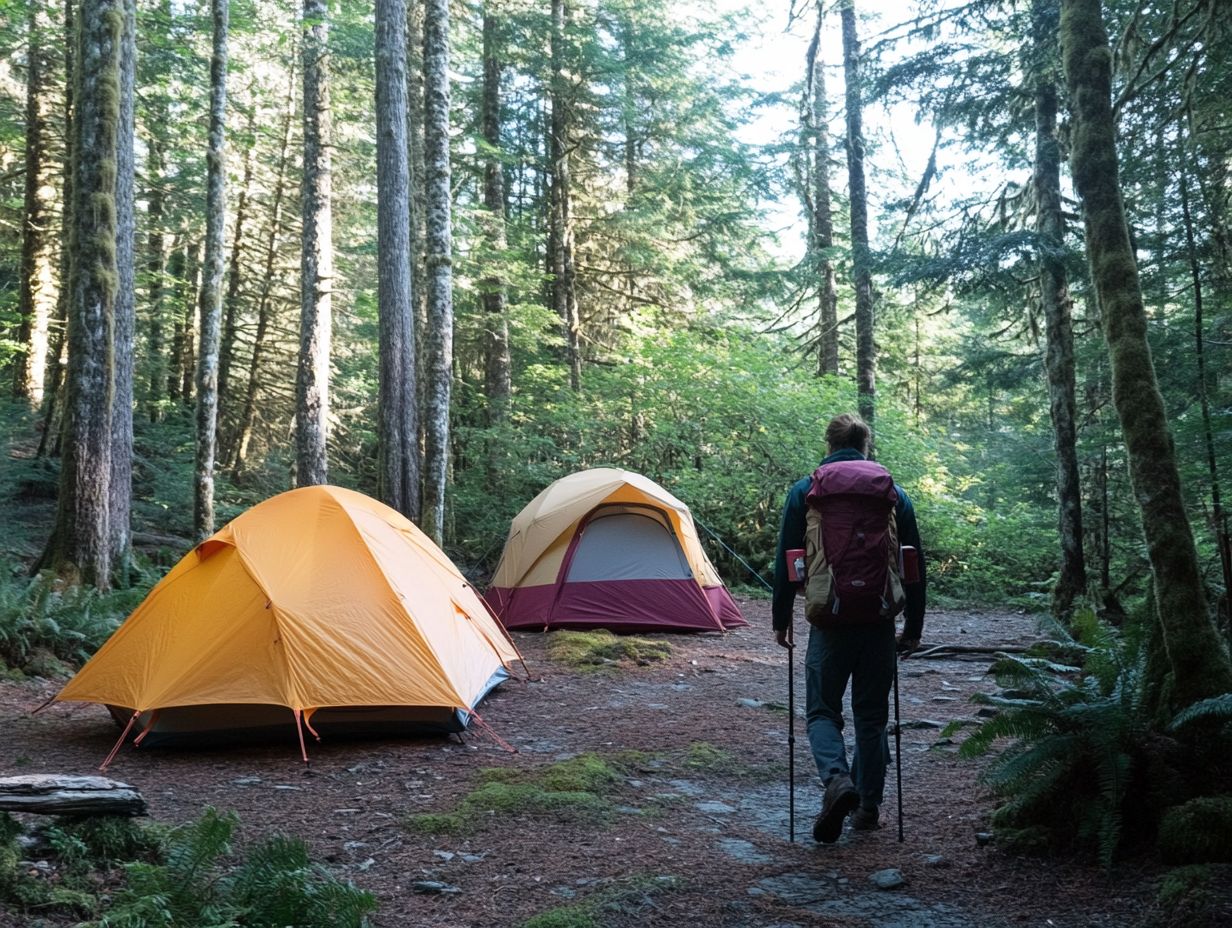
Regularly cleaning and storing your camping gear is essential for extending the life of your backpacking tent and ensuring it’s always ready for your next adventure.
After each trip, take a few moments to care for the fabric, zippers, and poles. This simple act can vastly improve performance over time.
Start by shaking out any dirt and debris from both the inside and outside of the tent. If needed, give it a gentle wash with mild soap and water. Once you ve rinsed it thoroughly, remember to let it air dry completely to prevent any mildew from making an unwelcome appearance.
During this cleaning process, take the time to inspect the tent for any signs of wear and tear. Catching minor issues early can save you significant headaches later.
Finally, store your tent in a cool, dry place, away from direct sunlight. Proper storage will keep your tent in top shape, ready for your next thrilling adventure!
Frequently Asked Questions
What should I consider when choosing the right tent for backpacking?
When choosing a tent for backpacking, it is important to consider factors such as weight, size, durability, seasonality, and ease of setup. These factors will affect the overall comfort and functionality of your tent during your backpacking trip.
How do I determine the appropriate size of tent for backpacking?
The size of your tent should be based on the number of people that will be using it. However, keep in mind that backpacking tents tend to be more snug and lightweight, so a 2-person tent may only comfortably fit 1 person. Consider the size and type of gear you will be storing in the tent as well.
What is the difference between a 3-season and 4-season tent?
3-season tents are designed for use during spring, summer, and fall, and are suitable for mild weather conditions. 4-season tents are built to withstand harsher weather conditions, such as heavy rain, snow, and strong winds, making them ideal for winter or mountainous backpacking trips.
What materials should I consider for a backpacking tent?
Materials such as nylon, polyester, and ripstop, which is a strong fabric designed to resist tearing, are commonly used for backpacking tents, as they are lightweight and durable. Look for tents with a waterproof coating or a high waterproof rating to ensure you stay dry during wet weather.
How important is the weight of a backpacking tent?
The weight of a backpacking tent is crucial, as it will directly impact your comfort and mobility during your trip. Look for tents that are lightweight and compact, as they will be easier to carry and won’t add unnecessary weight to your pack.
Do I need to spend a lot of money on a backpacking tent?
The cost of a backpacking tent can vary greatly, but it is not necessary to spend a lot of money to get a good quality tent. Research different brands and read reviews to find a reasonably priced tent that meets your needs. Remember, investing in a durable and comfortable tent will be worth it in the long run.
Ready to choose the perfect tent? With the right tent, you re just a step away from unforgettable outdoor experiences!


